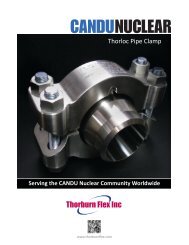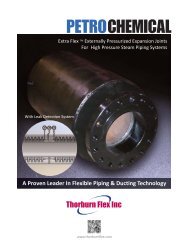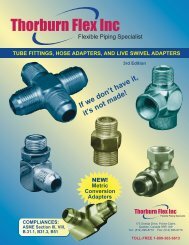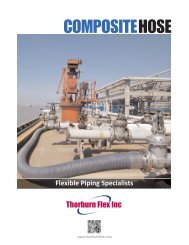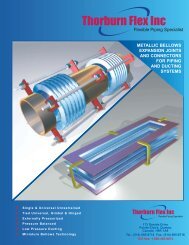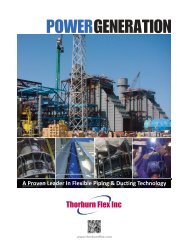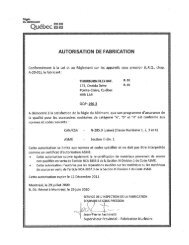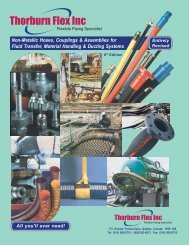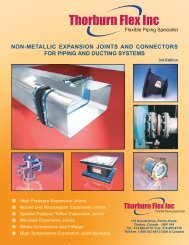Hydraulic Hose Assemblies - Thorburn Flex Inc
Hydraulic Hose Assemblies - Thorburn Flex Inc
Hydraulic Hose Assemblies - Thorburn Flex Inc
Create successful ePaper yourself
Turn your PDF publications into a flip-book with our unique Google optimized e-Paper software.
Technical Data7. Symptom: The hose appears flattened outin two areas and kinked. It has burst in thisarea and also appears twisted.Cause: Torquing of a hydraulic control hosetears loose the reinforcement layers andallows the hose to burst through enlargedgaps between the braided plaits of wirestrands. Use swivel fittings or joints to avoid atwisting force on a hydraulic hose.8. Symptom: The hose tube is broken loosefrom the reinforcement and piled up at theend of the hose. It may protrude from theend of the hose fitting.Cause: Likely cause: high vacuum or wronghose for the vacuum service. No vacuum isrecommended for double wire braid, 4 and 6spiral wire hose unless an internal coil supportis used. This type of failure may happen evento a hose rated for vacuum service, if it iskinked, flattened out or bent too sharply, .9. Symptom: The hose has burst about six toeight inches away from the end fitting. Thewire braid is rusted. There are no cuts orabrasions of the outer cover.Cause: Improper assembly of the hose endfitting allows moisture to enter around theedge of the fitting socket. The moisture willwick through the reinforcement.The heat generatedby the system will drive it out aroundthe fitting area, but six inches away it will betrapped between inner liner and outer cover,causing corrosion of the wire reinforcement.10. Symptom: There are blisters on the coverof the hose. If one pricks the blisters, oil willbe found in them.Cause: A tiny pinhole in the hose tube isallowing high pressure oil to seep betweenit and the cover. Eventually, it will form ablister where the cover adhesion is weakest.For a screw-together reuseable fitting,insufficient lubrication of the hose and fittingcan cause this condition because the drytube will adhere to the rotating nipple andtear enough to allow seepage. Faulty hosecan also cause this condition.11. Symptom: Blistering of the hose coverwhere a gaseous fluid is being used.Cause: High pressure gas effuses throughthe hose tube, gathering under the coverand soon forming a blister where the adhesionis weakest. Specially constructedhoses are available for high pressuregaseous applications. Your <strong>Thorburn</strong> representativecan advise you on the properhose to use in these cases.12. Symptom: Fitting blew off end of hose.Cause: Wrong fitting on the hose. Recheck<strong>Thorburn</strong>’’s specifications and part numbers.For a crimped fitting, the wrong machinesetting can result in over- or undercrimping.The socket of a screw together-fittingfor multiple wire braided hose may be wornbeyond its tolerance.The swaging dies in aswaged hose assembly may be wornbeyond <strong>Thorburn</strong>’s tolerances.The fitting may have been appliedimproperly to the hose. Check <strong>Thorburn</strong>’sinstructions. The hose may have beeninstalled without leaving enough slack tocompensate for the possible 4% shorteningthat may happen when a hose is pressurized,imposing great force on the fitting. Thehose itself may be out of tolerance.13. Symptom: The tube of the hose is badlydeteriorated with evidence of extremeswelling. In some cases, the hose tubemay be “washed out”.Cause: This indicatesthat the hose tube is notcompatible with theagent being carried.Even though the agentis normally compatible,the addition of heat canbe the catalyst that cancause inner liner deterioration. Consult<strong>Thorburn</strong> for a compatibility list. Make sureneither the internal nor the external operatingtemperatures exceed recommendations.14. Symptom: The hose has burst. The hosecover is badly deteriorated and the surfaceof the rubber is crazed.Cause: This could be simply old age. Thecrazed appearance is the effect of weatheringand ozone over a period of time. Tryto determine the age of the hose.<strong>Thorburn</strong> prints or embosses the date onthe outside of the hose.15. Symptom: The hose leaks at the fittingbecause of a crack in the metal tube adjacentto the braze on a split flange head.Cause: Because the crack is adjacent tothe braze, this is a stress failure brought onby a hose that is trying to shorten underpressure, but does’t have sufficient slack todo so.This problem can be cured by lengtheningthe hose assembly or altering therouting to relieve the forces on the fitting.16. Symptom: A spiral reinforced hose hasburst and literally split open with the wireexploded out and badlyentangled.Cause:The hose is too short toaccomodate the changein length occurring while it is pressurized.17. Symptom: The hose hasn’t burst, but isleaking profusely. A bisection of the hosereveals that the tube has been gougedthrough to the wire braid for a distance ofabout two inches.Cause: Indicates erosion of the hose tube.A high velocity needle-like fluid stream beingemitted from an orifice and impinging at asingle point on the hose tube will hydraulicallyremove a section of it. Be sure thehose is not bent close to an orificed port.18. Symptom: The hose is badly flattenedout in the burst area. The tube is veryhard downstream of the burst butappears normal upstream of the burst.Cause: The hose has been kinked either bybending it too sharply or by squashing it soas to create a major restriction. As the velocityof the fluid increases through the restriction,the pressure decreases to the vaporizationpoint of the fluid being conveyed.Often called cavitation, it causes heat andrapid oxidation to occur, hardening the hosetube downstream of the restriction.19. Symptom: The hose fitting has been pulledout of the hose. The hose has been considerablystretched out in length. This may notbe a high pressure application.Cause: Insufficient support of the hose.Very long lengths of hose must be supported,especially if vertical. Otherwise, theweight of the hose along with the weight ofthe fluid in it will be imposed on the hose fitting.This force can be transmitted to a wirerope or chain by clamping the hose to itmuch like the utilities support bundles ofwire from pole to pole. Leave sufficient slackin the hose between clamps to compensatefor possible 4% shortening that can occurwhen the hose is pressurized.20. Symptom: The hose has not burst, but itleaks profusely. A bisection of the hosereveals an inward burst.Cause: Often known as hose tube blowdown,this type of failure is usually associatedwith very low viscosity fluids such as air,nitrogen, freon, and other gases. Under highpressure conditions, the gases effuse intothe pores of the hose tube charging them uplike miniature accumulators. If the pressure issuddenly reduced to zero, the entrappedgases literally explode out of the tube, oftentearing holes in it. In some hose constructions,a second hose tube made from a plasticsuch as nylon, is inserted into the hose.A small leak allows the gaseous fluid toseep between the two inner liners andwhen the pressure is reduced to zero, theinnermost liner will collapse because of thetrapped pressure around its outer diameter.8




